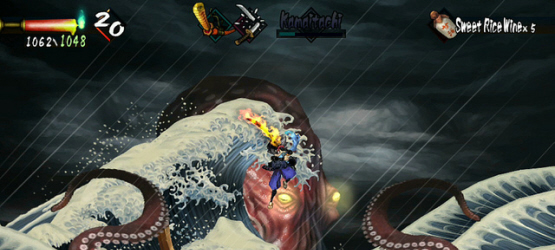Muramasa: The Demon Blade originally released in 2009 for the Nintendo Wii. It was generally well-received – a hack-n-slash that worked well with the limited controls of the Wii Remote. The game has now been ported to the PlayStation Vita, and is finally available in the States. So does this port make the cut? We’ll tell you in our review.
Let’s get this out of the way: Rebirth is a gorgeous game. The Demon Blade looked pretty good on the Wii, but it absolutely shines on the Vita. The hand-drawn art is a wondrous thing to behold. The Vita’s five-inch OLED screen brings the entire game to life.
In Muramasa Rebirth, you can choose between two separate campaigns – that of Momohime, a princess whose body has been possessed by a swordsman, and Kisuke, a young, amnesiac ninja who has no idea why he is being chased. The campaigns are parallel and can be played in any order. It should also be noted that while the game offers two difficulty levels, the beginning level is truly for beginners. Most gamers will find little to no challenge in that mode. You can also only save the game at designated save spots – no on-the-fly saving here.
Muramasa Rebirth has a deceptively simple control scheme. You use the left analog stick to move, X to jump, Square to attack, Circle to utilize a special “Secret Art” move, and Triangle to select between three different swords. As you progress through the game, you obtain and can craft newer, better blades which have different Secret Arts. There are a ton of blades, each with their own advantages and disadvantages, which generally fall into one of two categories. Blades are quick but weaker weapons, and Long Blades are slower but stronger.

Combat can be as deep or as shallow as you want in Rebirth. If you hold Square down, you block by default. Time it right, and you fling back any projectiles launched your way. This wears down your blade’s “Soul Gauge,” and can actually break your blade before too long. Once this happens, you are essentially defenseless until you change to either of your other equipped blades – you can only have up to three blades equipped at any one time. A well-timed blade switch can decimate an entire screen of enemies. Once the Soul Gauge is filled, you can utilize the Secret Art, a unique move to each blade. Some Secret Arts send you into a spinning, slashing frenzy, whereas others protect you with electric orbs that hurt any enemies they touch. There is a decent variety of Secret Arts to be found.
You can also talk to various NPCs in the game, some of whom will have items to purchase with the money you pick up while fighting. Some of these are recipes, which you can use to craft items that help you along. This includes food such as rice balls, which heal a lot and don’t fill you up like other foods. This “fullness” meter can prevent you from consuming another healing item within a short span of time, something to think about when in battle. Making these items is pretty simple if you have the ingredients, but it is kind of funny to have to press Circle multiple times to take the lid off your bowl of rice, then again to pick up the rice, then a few more times to squeeze the rice together, again to add some seaweed, and finally to take the rice ball from the bowl.
Muramasa Rebirth is a fun game, but it is very linear. Yes, you can craft some pretty unique weapons, but the game basically consists of killing a screen of enemies, then moving on, ad nauseum. There are some wonderful boss fights, which definitely helps to break up the monotony. The game even has a sense of humor scattered throughout, and the fully-voiced characters are much appreciated. Cutscenes are pretty sparse, but given how beautiful the game looks you will hardly notice.
For fans of Vanillaware’s games, this is a no-brainer. Muramasa Rebirth is the more complete version of its Wii predecessor. With an amazing art style, fast action, and even some humor, sidescroller fighting game fans will find a lot to like here. This is one of the Vita’s prettiest games, and is fun to boot!
-
Large variety of blades to acquire and craft.
-
Two separate campaigns double your playtime.
-
Beautiful artwork looks fantastic on the Vita.
-
Game is very linear despite its crafting depth.
-
Combat can get repetitive.








